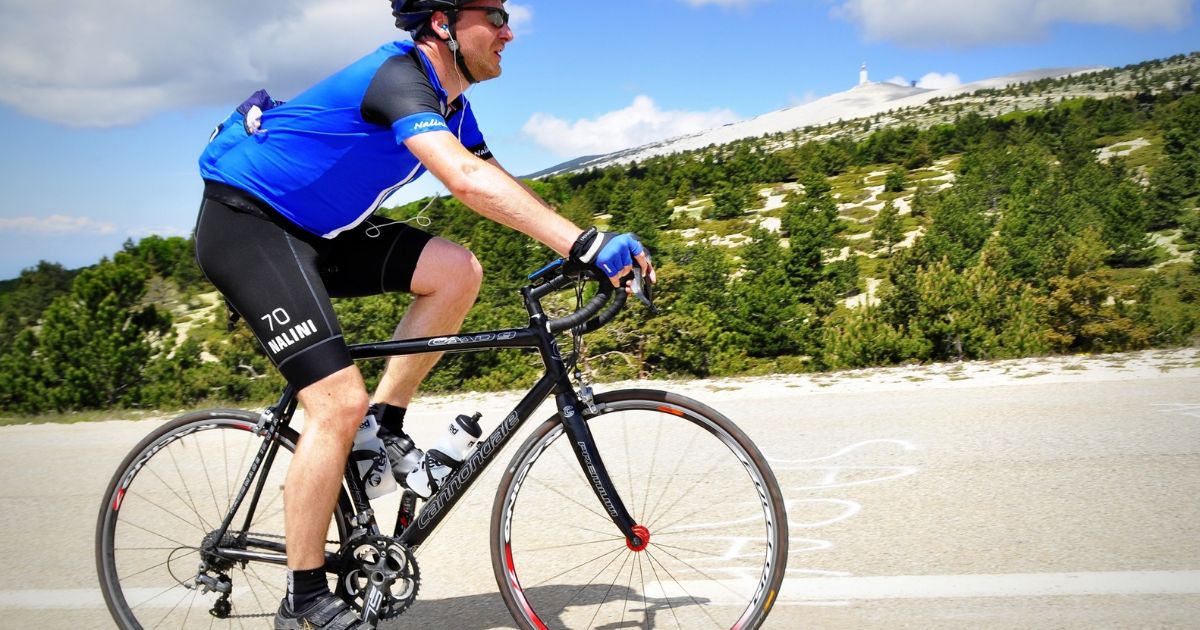Level Up Your Nutrition Game With Our Freebies
Alex
I provide nutrition coaching for endurance athletes to improve performance and body composition through a simple and flexible eating style.
Hi, I'm
ATHLETE EATING GUIDE →
LEARN MORE →
ATHLETE GROCERY SHOPPING GUIDE →
10-DAY PROTEIN-PACKED SAMPLE MEAL PLAN
READY TO FUEL?
incredible value!
The fueling guide bundle serves as your one-stop-shop for strategies to fueling before, during and after your workouts.
The power-to-weight ratio is a measurement of an athlete’s ability to generate power in relation to their body weight. It’s a metric, used primarily in cycling with a power meter that measures watts of power produced.
When used correctly it can provide useful insights in training and help show performance gains over time. And in other cases, athletes can use it as an excuse to have an unhealthy obsession with their weight.
To calculate your ratio, simply divide your average power (watts) by your weight in kilograms (weight in lbs/2.2). For example, a 160 lb/72.6 kg cyclist that averages 160 watts on the bike would have a ratio of 2.2.
Is the power-to-weight ratio important in cycling?
It’s simply a form of measurement, it is not the end-all-be-all factor of success for an athlete. Power-to-weight plays the biggest role when it comes to long and steep climbing on the bike.
Our dietitian team has worked with many cyclists and triathletes. It’s common for us to see an athlete’s mindset fixated on weight loss to maximize their power-to-weight ratio. This can often be an unhealthy fixation and counterproductive to improving as an athlete. From our perspective, we strive to help athletes optimize that ratio!
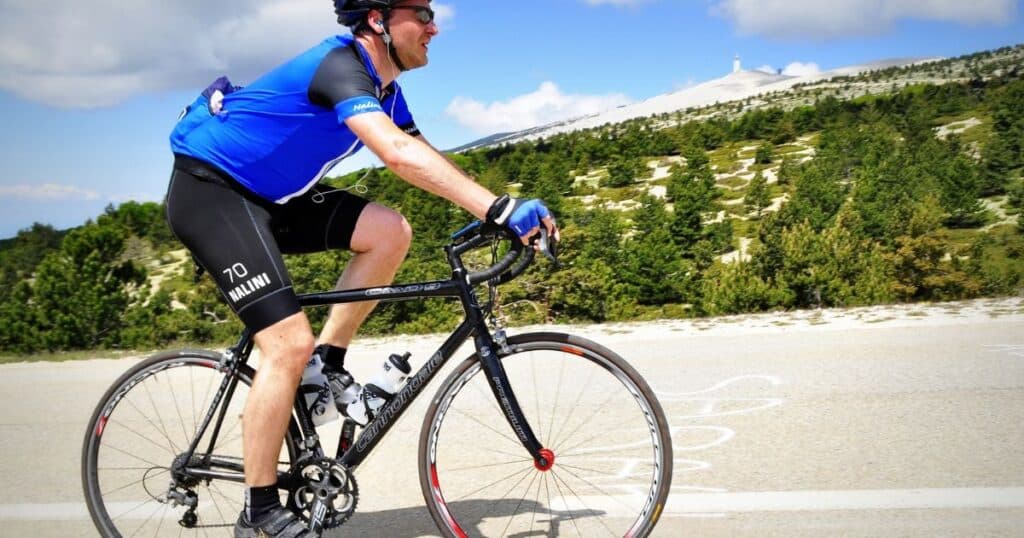
Nutrition’s Key Role in Optimizing Power-to-Weight Ratio?
Nutrition can be a very effective tool for improving your power-to-weight ratio. A balanced diet helps reduce excess body fat while preserving muscle, making the cyclist more efficient in generating power. Proper nutrition also provides the energy and nutrients needed for peak performance, especially during challenging climbs and sprints.
When we work with cyclists looking to improve their power-to-weight ratio, we employ a few different strategies.
Nutrition Strategies for Improving Power-to-Weight Ratio
First, it is important to estimate calorie needs and energy balance. There are many factors that go into how much an athlete should be eating. How many calories you should eat will depend on factors such as:
- Your training schedule
- Gender
- Age
- Height and weight
- Overall activity level, including non-exercise activities
- Medical conditions
- And more!
Endurance athletes, including cyclists, do have higher nutrition needs compared to non-athletes. You will want your calorie intake to be more than the amount of energy you are exerting through training. If you are looking to lose body fat, you’ll need to be in a calorie deficit. Though this is typically best to implement during the off-season or your performance will likely suffer.
Don’t worry, you don’t actually have to count your calories every day to know how much you should eat. While it may be helpful for beginners to use a food journal, over time you will be able to listen to your body and judge if you are eating enough or too much.
Next, it is important to ensure that you are optimizing macronutrient intake for performance.
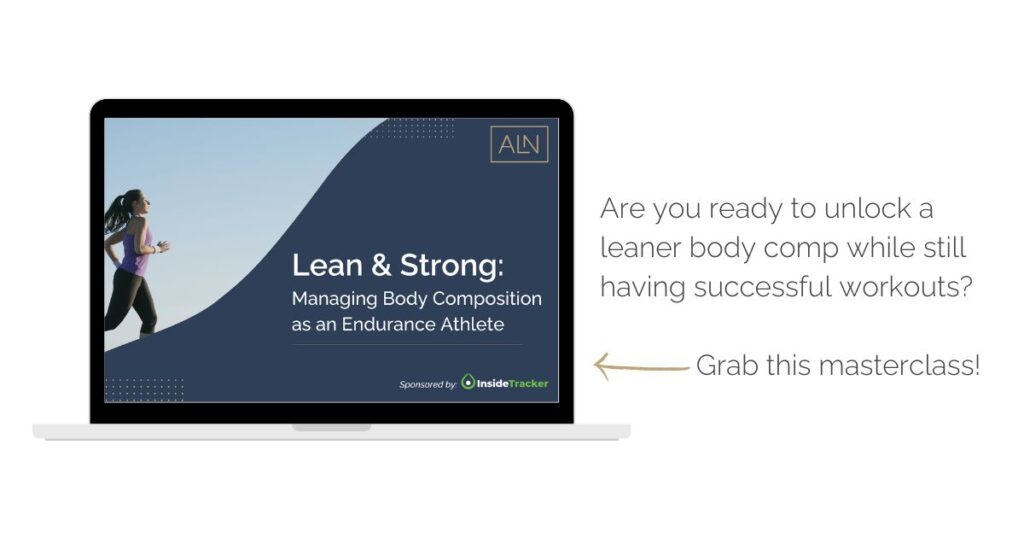
Macronutrient Composition for Optimal Performance
Popular fad diets are not ideal for nutrition performance. Focus on taking a balanced and sustainable approach to your nutrition without cutting out any major food groups.
Ideally, when planning your meals and snacks to fuel your training, you want to include the right foods. Let’s walk through the key features of those food choices.
Carbohydrates:
Carbohydrates are premium fuel when it comes to filling your nutrition tank because carbohydrates are the most efficient source of energy. When you consume carbohydrates, your body breaks them down into glucose (sugar). Glucose will be used for exercise or converted into muscle glycogen to be stored and used later.
Typically, most cyclists require at least 55% of their calorie intake from carbohydrates. However, this can vary based on factors such as duration and intensity of the ride and carbohydrate-loading for an upcoming race. It is important to recognize that not all carbohydrates are the same. During training, you will be consuming both simple and complex carbohydrates for fuel.
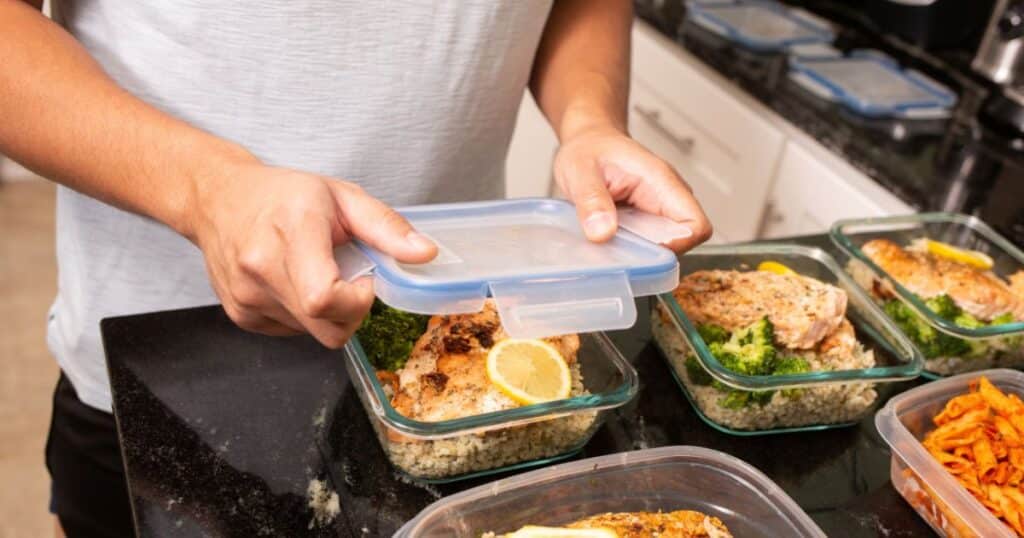
Simple carbohydrates:
Simple carbs are easy to digest and are found in foods such as:
- raw sugar,
- energy gels,
- energy or sports drinks,
- fruit and fruit juices,
- soda,
- candy,
- and foods with added sugars such as cookies and desserts.
Foods that are high in simple carbohydrate content are low in dietary fiber and break down quickly to be used as energy. These foods are effective while training to provide quick bursts of energy.
During your training rides, take in enough simple carbohydrates to avoid running out of fuel in the tank (aka: “hitting a wall”). Typically 60-90g of simple, easy-to-digest carbohydrates per hour, depending on the length of the workout, is the target range for most cyclists. It is incredibly key to experiment with fuel sources, such as energy gels, while training. This is to ensure that you will tolerate and minimize any risk of stomach cramps and upset on race day.
Complex carbohydrates:
Complex carbs take longer to digest. They’re found in higher-fiber, nutrient-dense foods. Such as:
- Whole grains (barley, brown rice, quinoa, oats)
- Legumes including beans and lentils
- Starchy vegetables, including sweet potatoes, potatoes, pumpkin, among others.
These foods are excellent to include throughout the day in meals and snacks to boost your vitamin and mineral intake. Many fad diets recommend cutting carbohydrate intake for body fat loss which may lead to weight loss, but usually in the short term. Most often we see significant disruptions to training and performance when carbohydrate intake is decreased for a prolonged period of time.
Protein:
Research supports that adequate protein in endurance athletes, including cyclists, speeds up muscle recovery and offsets muscle damage. Most endurance athletes will benefit from 1.2-2.0g of protein per kilogram of body weight, which should be spaced throughout the day.
Lean protein-rich food sources include:
- poultry,
- fish,
- beef,
- pork,
- eggs,
- low-fat dairy including Greek yogurt and cottage cheese,
- soy, including tofu, tempeh, seitan, edamame,
- beans and lentils,
- and protein powder supplements.
Most athletes fall short of their protein targets on a regular basis. Meeting those needs doesn’t need to be overcomplicated. If you are constantly falling short on protein, consider a few of these tactics:
- Topping your toast with an egg (or two).
- Adding a scoop of low-fat cottage cheese or Greek yogurt with your fruit smoothie.
- Making your own trail mix with dried edamame, pumpkin seeds, and pretzels.
We have a number of awesome ALN blog articles on getting more protein:
5-Day Sample High-Protein Meal Plans: Easy Ways To Eat More Protein
10 High-Protein Breakfast Ideas for Athletes
10 Easy High-Protein Lunch Ideas for Athletes
Easy Protein Snack Pack Ideas for Endurance Athletes
5 Easy Ways to Eat More Plant-Based Protein
Healthy fats:
Adequate dietary fat intake is important for giving your body enough fuel for training, helps with vitamin absorption, and decreases inflammation. About ~20-30% of your diet should include healthy fat sources such as olive oil, nuts and seeds, olives, and avocado. Flaxseed, chia seed, and walnuts are extremely rich sources of omega-3 fatty acids. Research shows that regular consumption of omega-3s can help reduce inflammation from training demands.
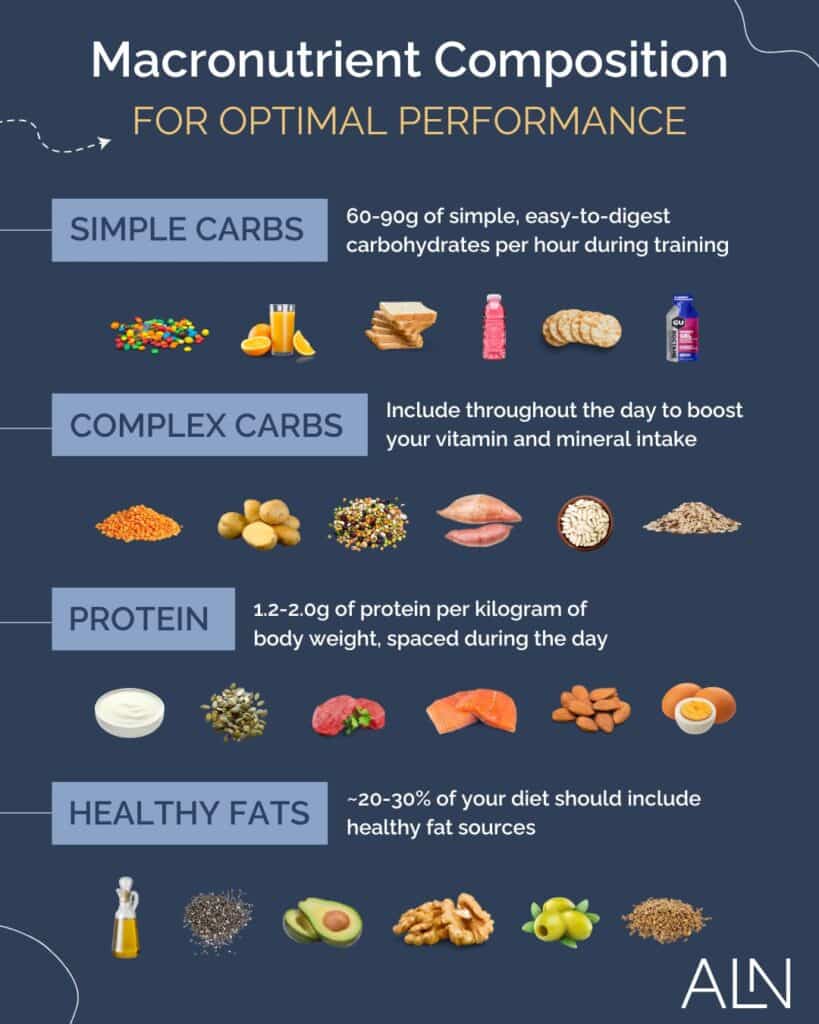
Optimizing Body Composition Goals
If you are looking to improve body composition, building muscle may be an integral first step. Typically an increase in muscle mass can be achieved through a consistent strength training routine and also adequate protein and calorie intake.
If you’re struggling to meet your increased protein needs through food, supplementing with options such as a protein powder can be an effective tool. Protein powder provides a quick, convenient solution, especially when you’re on the go and need something portable. Choosing a quality protein powder will offer a concentrated and easily digestible protein source. They’re designed to be absorbed quickly and deliver the needed amino acids to your recovering muscles.
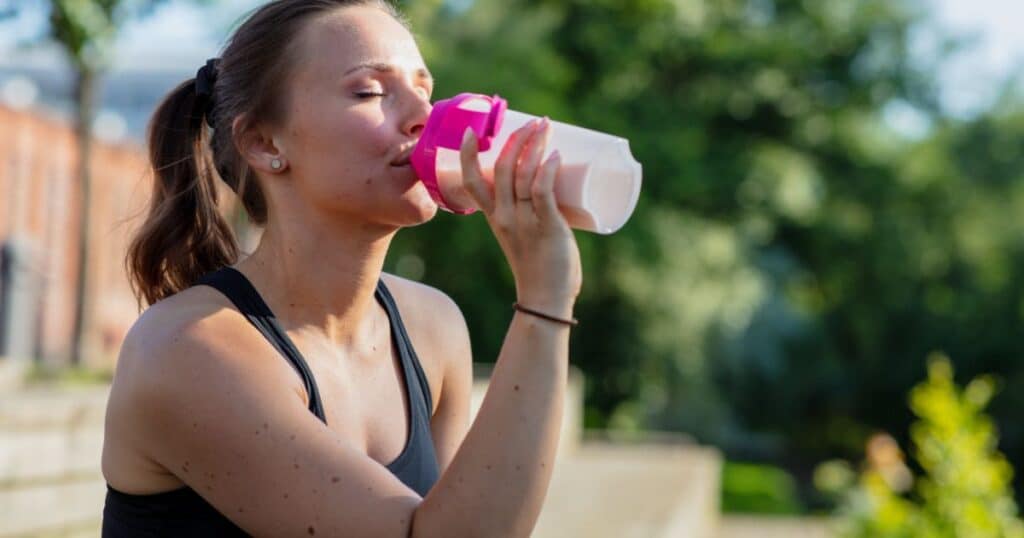
I’m a big fan of Thorne (whey and plant-based options) supplements. I love Thorne’s whey protein isolate powder! This affiliate link will get you 15% off your order (discount applies at checkout).
Protein powders come in a variety of forms. When reviewing ingredient labels, look for protein isolates as that indicates it will be 90%+ protein. The ingredient list says protein concentrate which can vary anywhere from 30-89% depending on the brand.
Whey protein is the most popular due to its superior amino acid profile and it’s well-known for being quickly absorbed. Casein protein is a slow-release amino acid and makes a great option for bedtime to support muscle recovery overnight. And plant-based protein powders will vary in quality. Plant-based powders will often have a variety of sources to get a more diverse amino acid profile. They also may have additives such as digestive enzymes to increase absorbability.
Measuring Body Composition Progress
Tracking progress through body composition assessments and analysis may be helpful. If you are looking for an objective assessment of body composition and progress, consider having a DEXA (dual x-ray absorptiometry) scan performed. This is the gold standard in body composition testing. Other assessment methods are also available. InBody (bioelectrical impedance) testing is widely available, though results can be more sensitive to hydration fluctuations.
Avoiding Common Pitfalls
While it is easy to fall into the mindset that lighter is better. It’s important to prioritize a flexible and sustainable nutrition plan for fueling those miles. Avoid any restrictive or fad diets or other restrictive diets.
A common tactic we see athletes take is restricting their calorie intake in an effort to reach a more ideal race weight. This is the wrong tactic to attempt as it also will lead to your power and strength significantly decreasing, and potentially lead to RED-S.
Working with a Sports Dietitian
There is no one-size-fits-all approach to nutrition recommendations for cyclists. Every athlete is truly unique in their individual nutrition needs based on a wide variety of factors. While putting the pieces to the nutrition puzzle may seem overwhelming, it doesn’t have to be.
If you are struggling to put the pieces of the puzzle together, reach out! We can ensure you are well-fueled and riding on. If you are in an off-season, this is an excellent time to optimize your day-to-day nutrition habits and fueling strategies heading into your next training cycle.
For individualized guidance and support on fueling your training and ultimately your race, reach out, and let’s talk about 1:1 nutrition coaching. We provide personalized accountability and strive to teach you how to create a sustainable and flexible eating style to meet your needs as a cyclist.
Alex
I provide nutrition coaching for endurance athletes to improve performance and body composition through a simple and flexible eating style.
Hi, I'm
LEARN MORE →
take the quiz!
Let's discover your Endurance Nutrition IQ
How well do you know your fueling? Answer these questions and let's see where your endurance nutrition knowledge is at!
Take the quiz
level up your nutrition game with these freebies
free downloadS
Protein-Packed 10-Day Sample Meal Plan
Athlete Eating Guide
Athlete Grocery Shopping Guide
1
2
3
Inspiration to fit 120 grams of protein into your day
Planning what goes on your plate
Putting the right foods in your grocery cart
